Stainless Steel Investment Casting Pipe Fittings
Introduction
Stainless steel investment casting is a precision casting process delivering high dimensional accuracy (±0.1 mm tolerance) and superior surface finishes (Ra 3.2 µm). At Neway AeroTech, we utilize advanced vacuum investment casting technologies to produce complex stainless steel pipe fittings widely used in demanding sectors such as oil and gas, chemical processing, and power generation.
These fittings exhibit exceptional corrosion resistance, mechanical strength (>600 MPa tensile strength), and durability in high-pressure (up to 50 MPa) and high-temperature (up to 600°C) environments, making them essential components in critical infrastructure and industrial applications.
Core Technology of Stainless Steel Investment Casting
Wax Pattern Formation: Wax patterns are precisely created using metal dies, ensuring dimensional accuracy within ±0.05 mm.
Ceramic Shell Mold Creation: Patterns repeatedly dipped into ceramic slurries, building layers up to 8–12 mm thick, to ensure mold robustness.
Dewaxing: Molds are heated to approximately 200°C for wax removal, leaving precise cavities that replicate component geometry exactly.
Vacuum Investment Casting: Molten stainless steel (1500–1600°C) is poured into molds under vacuum to prevent oxidation, ensuring defect-free castings.
Mold Removal and Finishing: Ceramic shells mechanically removed; castings cleaned, inspected, and finished to achieve surface roughness below Ra 3.2 µm.
Heat Treatment: Solution annealing at around 1050°C improves corrosion resistance, mechanical properties, and dimensional stability.
Material Characteristics of Stainless Steel for Pipe Fittings
Property | Specification |
|---|---|
Common Grades | 304, 304L, 316, 316L, 321, 347, 2205 Duplex |
Tensile Strength | 600–700 MPa |
Yield Strength | ≥300 MPa |
Corrosion Resistance | Excellent, especially in chloride environments |
Operating Temperature | Up to 600°C |
Dimensional Tolerance | ±0.1 mm |
Surface Roughness | Ra ≤3.2 µm |
Pressure Rating | Up to 50 MPa |
Case Study: Stainless Steel Investment Casting Pipe Fittings
Project Background
A global petrochemical company required precision-manufactured stainless steel pipe fittings for use in corrosive and high-pressure pipelines. Key objectives included durability, corrosion resistance, and precision to meet stringent industry standards.
Common Pipe Fitting Models and Applications
Elbows (45° and 90°): Ensuring smooth directional flow under pressures of 25–50 MPa in chemical processing systems.
Tees (Equal and Reducing): Facilitating reliable distribution and mixing in high-temperature environments up to 550°C within power generation plants.
Flanges (Slip-on, Weld-neck, Blind): Providing secure, leak-proof connections in pipelines operating at pressures up to 40 MPa in oil and gas infrastructure.
Couplings and Unions: Allowing quick, reliable assembly and disassembly for maintenance in critical pharmaceutical and food piping systems.
Selection and Structural Features of Typical Pipe Fittings
Selected stainless steel grades (primarily 316L and 2205 Duplex) offered enhanced resistance to chloride-induced corrosion and improved mechanical strength. Structural designs prioritized uniform wall thickness, precision threading, and optimized internal geometry for minimized pressure losses and enhanced fluid dynamics.
Pipe Fittings Manufacturing Solution
Precision Wax Injection: High-accuracy wax patterns formed within ±0.05 mm tolerance to guarantee dimensional repeatability.
Robust Ceramic Mold Construction: Ceramic mold shells are created with controlled thickness (8–12 mm) to withstand casting pressures without deformation.
Vacuum-Assisted Casting: Stainless steel melted at 1550°C poured into molds under vacuum (<0.01 MPa oxygen atmosphere) to prevent impurities.
Heat Treatment: Annealing at 1050°C to enhance corrosion resistance and homogenize mechanical properties throughout the component.
Precision Machining: CNC machining ensures final dimensions within ±0.1 mm tolerances and internal threading accuracy of ±0.05 mm.
Surface Finishing: Polishing and passivation are performed to achieve a surface finish below Ra 3.2 µm, further improving corrosion resistance.
Non-destructive Testing (NDT): Ultrasonic and radiographic X-ray testing performed to detect internal flaws, ensuring full compliance with ASME and ASTM standards.
Pressure Testing: Components tested at pressures up to 60 MPa to validate operational safety margins and leak-tight integrity.
Core Manufacturing Challenges
Ensuring tight dimensional tolerances (±0.1 mm) for precise fitting assembly
Achieving uniform mechanical properties across castings
Minimizing casting defects (porosity, inclusions) through vacuum casting
Confirming corrosion resistance through thorough testing and validation
Results and Verification
Dimensional Accuracy: Achieved and verified dimensions within ±0.1 mm using Coordinate Measuring Machine (CMM).
Mechanical Strength Validation: Tensile tests consistently recorded strengths above 650 MPa, exceeding project requirements.
Corrosion Resistance Testing: Passed ASTM-standard salt spray and immersion tests, confirming exceptional resistance in chloride environments.
NDT Inspection: Radiographic and ultrasonic testing confirmed defect-free components, meeting stringent industrial standards.
Pressure Test Validation: Successfully sustained operational pressures above 50 MPa, verifying safety and reliability.
Surface Finish Verification: Surface roughness confirmed consistently below Ra 3.2 µm, significantly reducing corrosion initiation points.
FAQs
What dimensional accuracy can Neway AeroTech achieve for stainless steel investment casting pipe fittings?
Which stainless steel grades are most commonly used for high-pressure pipe fittings?
How does Neway AeroTech ensure corrosion resistance in pipe fittings?
What NDT methods does Neway AeroTech use to ensure fitting quality?
Can Neway AeroTech customize fittings to meet specific industry standards and requirements?

